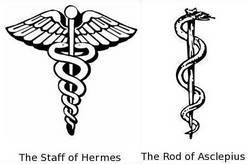The University School of Nursing is going to change the symbol that they use for logos and branding due to a misinterpretation of symbology.
Currently, the School of Nursing and most medical organizations use a symbol called the caduceus, which in Greek mythology is known as the staff of Hermes, the messenger god. In the same mythology, the god of medicine was known as Asclepius and used the Rod of Asclepius.
The incorrect symbol usage was spotted by Janna Bogan, a nursing student who learned about the correct symbology in a fall semester literature class.
Bogan said, “Having the right symbol is important, and makes health care professionals stand out when they acknowledge the true symbol as the rod of Asclepius. If someone is wearing the wrong symbol, it might make an organization look fraudulent or not credible.”
Throughout history, the caduceus has been mistaken for the Rod of Asclepius due to their similar appearance, but represent different things. “In symbolic significance, each symbol represents its ancient Greek deity and that deity’s attributes,” said Stanley Blair, an associate professor of English.
“Hermes is best known as the messenger god, but he was also the god of thievery and moneymaking, while Asclepius was the god of medicine. Both gods were worshiped in ancient Greece and Rome,” Blair continued.
“In appearance, the caduceus consists of a staff with two intertwining snakes, topped usually by a sphere and a pair of wings. In earlier artistic representations of Hermes, often the wings are absent from his staff because they are depicted instead as being on his cap or ankles. The Rod of Asclepius consists of a rod with one intertwined snake.”
“[The caduceus] is often mistakenly used as the symbol of medicine instead of the Rod of Asclepius,” said Janet Mahoney, Ph.D., Dean of the School of Nursing and Health Studies. “The Nurs-ing School is going to use nursing symbols such as Florence Nightingale’s Lamp in future for funding raising purposes. It is interesting that society in the United States, to this day, identifies with the Caduceus as the symbol for medicine.”
According to Blair, research and studies show that medical professionals who are aware of the history of their profession tend to use the historically-accurate Rod of Asclepius, while medical-related businesses tend to use the more publically recognizable caduceus.
“Symbols and logos matter,” Blair explained. “They are so widely used because they are an effective non-verbal, visual means of conveying an important quality or attribute of an organization or brand, and thereby the organization or brand itself.
Symbols and logos are most effective when the public universally identifies them only with the organization or brand, and are less effective when the public sees them as having more than one significance. This is why many organization and most business logos are registered as trademarks, so that their public meaning can be limited to the meaning that the organization or business intends.”
“There are other meaning of words and historical events that people use all the time that are used with good intentions, said Mahoney. “For example, the use of the term jaundice. I have heard people use the term yellow jaundice. Jaundice means yellow.”
Blair said, “In the specific case of the caduceus and the Rod of Asclepius, on the one hand, the qualities associated with them have a long history extending back to ancient times. On the other hand, the use of the caduceus to signify medicine is a recent practice that started just over a century ago, mainly in the United States, and quite possibly accidentally.
Perhaps most troubling is that the qualities historically associated with the caduceus, such as moneymaking and thievery, seem very much the opposite of the qualities signified by the Rod of Asclepius.”
“In the United States, ancient Greek mythology is often taught around the eighth grade, sometimes earlier than that, said Blair. “However, while such teaching often mentions Hermes as a major deity in the ancient Greek pantheon, Asclepius was a more minor deity associated with Apollo and therefore is taught less often. So, theoretically, all Americans with an eighth-grade education could tell the difference. This may be even more the case with people who were educated outside of the United States.”
“I think changing the symbol of the Monmouth University nursing programs clothing attire is a step in the right direction, because the new education that I learned is being implemented,” said Bogan.
“The discussions of ancient Greek deity symbolism inside and outside the classroom, the courageous and professional actions of Ms. Bogan, and the steps taken by the School of Nursing and Health Studies all exemplify that the study of literature has consequences in real life, which is why literature is an important part of general e ducation at Monmouth University,” said Blair.
IMAGE TAKEN from DailyRounds



